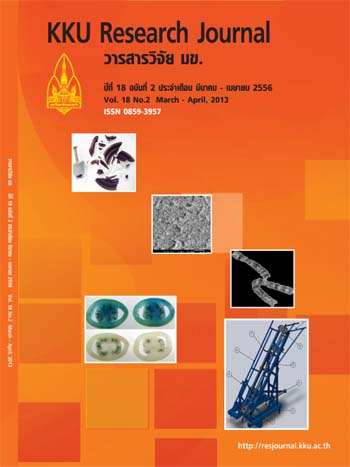Investigation of the self-cleaning properties of cotton fabrics finished with Nano-TiO2 and Nano-TiO2 mixed with fumed silica.
Main Article Content
Abstract
The aim of this work is to investigate the self-cleaning properties of woven cotton fabrics after coating with either nanoparticles of TiO2 (Degussa, P-25) or mixtures of P-25 and fumed silica (Aerosil200). The TiO2 and fumed silica were dispersed in toluene by exposure to ultrasound and then stirring prior to use. After drying, the particles were dispersed in water at 0, 0.5, 1.0 and 2.0 wt/wt% then applied to the cotton fabrics using a pad-dry-cure technique. The finished fabrics were stained with direct dye, coffee, tomato sauce, and soft drink, and then irradiated with artificial sunlight (xenon arc lamp) for 24 h. The K/S values at different time intervals were recorded to measure the self-cleaning ability of the finished fabrics. The results showed that every sample possessed self-cleaning abilities. The self-cleaning effect was stronger for samples coated with higher TiO2 concentrations. The decomposition of a direct dye stain was most significant compared to other stains. Mostly, the finished samples appeared clean after one wash whereas the untreated fabrics required repeated washing. However, with the addition of fumed silica, a reduction in self-cleaning ability was observed.
Article Details
References
[2] Kathirvelu S, D’Souza L, Dhurai B. Nanotechnology applications in textiles. Indian J Sci Technol. 2008;1(5): 1-10.
[3] Bozzi A, Yuranova T, Guasaquillo I, Laubb D, Kiwi J. Self-cleaning of modified cotton textiles by TiO2 at low temperatures under daylight Irradiation. J Photochem Photobiol, A. 2005;174(2): 156-164.
[4] Liu G, Yan X, Chen Z, Wang X, Wang L, Lu GQ, Cheng HM. Synthesis of rutile–anatase core–shell structured TiO2 for photocatalysis. J Mater Chem. 2009;19(36): 6590-96.
[5] Mills A, Lee SK, Lepre A. Photodecomposition of ozone sensitised by a film of titanium dioxide on glass. J Photochem Photobiol, A. 2003;155(1-3): 199-205.
[6] Gupta KK, Jassal M, Agrawal AK. Functional finishing of cotton using titanium dioxide and zinc oxide nanoparticles. RJTA. 2007;11(3): 1-10.
[7] Qi K, Wang X, Xin JH. Photocatalytic self-cleaning textiles based on nanocrystalline titanium dioxide. Text Res J. 2010;81(1): 101-10.
[8] Meilert KT, Laub D, Kiwi J. Photocatalytic self-cleaning of modified cotton textiles by TiO2clusters attached by chemical spacers. J Mo Catal A: Chem. 2005;237(1-2): 101-108.
[9] Qi K, Daoud WA, Xin JH, Mak CL, Tang W. Cheung WP. Self-cleaning cotton. J Mater Chem. 2006;16(47): 4567-74.
[10] Montazer M, Seifollahzadeh S. Enhanced self-cleaning, antibacterial and UV protection properties of nano TiO2 treated textile through enzymatic pretreatment. Photochem Photobiol. 2011;87(4): 877-83.
[11] Bozzi A, Yuranova T, Kiwi J. Self-cleaning of wool-polyamide and polyester textiles by TiO2–rutile modification under daylight irradiation at ambient temperature. J Photochem Photobiol, A. 2005;172(1): 27-34.
[12] Dastjerdi R, Montazer M, Shahsavan S. A novel technique for producing durable multifunctional textiles using nanocomposite coating. Colloids Surf, B. 2010;81(1): 32-42.
[13] Jafry HR, Liga MV, Li Q, Barron AR. Simple route to enhanced photocatalytic activity of P25 titanium dioxide nanoparticles by silica additioEnviron Sci Technol. 2011;45(4): 1563-68.
[14] Golon A, Kuhnert N. Unraveling the chemical composition of caramel. J Agric Food Chem. 2012;60(12): 3266-74.
[15] Wang RH, Wang XW, Xin JH. Advanced visible-light-driven self-cleaning cotton by Au/TiO2/SiO2 photocatalysts. ACS Appl Mater Interfaces. 2010;2(1): 82-85.
[16] Sundaresan K, Sivakumar A, Vigneswaran C, Ramachandran T. Influence of nano titanium dioxide finish, prepared by sol-gel technique, on the ultraviolet protection, antimicrobial, and self-cleaning characteristics of cotton fabrics. J Ind Textil. 2011;0(00): 1-19.
[17] Gupta KK, Jassal M, Agrawal AK. Sol-gel derived titanium dioxide finishing of cotton fabric for self cleaning. Indian J Fibre Text. 2008;33: 443-50.
[18] Yuranova T et al. Discoloration of organic compounds on outdoor building cement panels modified by photoactive coatings. J Photochem Photobiol, A. 2007;188(2-3): 334-41.
[19] Mirabedini A, Mirabedini SM, Babalou AA, Pazokifard S. Synthesis, characterization and enhanced photocatalytic nanocomposite in an aqueous solution and acrylic-based coatings. Prog Org Coat. 2011;72(3): 453-60.
[20] Yuranova T, Mosteo R, Bandara J, Laub D, Kiwi J. Self-cleaning cotton textiles surfaces modified by photoactive SiO2/TiO2 coating. J Mo Catal A, Chem. 2006;244(1-2): 160-7.
[21] Veronovski N, Rudolf A, Smole MS, Kreže T, Geršak J. Self-cleaning and handle properties of TiO2-modified textiles. Fiber Polym. 2009;10(4): 551-6.
[22] Uddin MJ et al. Photoactive TiO2 films on cellulose fibres: synthesis and characterization. 2007;189(3): 286-94.


